Weighing Myocarditis Cases: CDC’s ACIP Committee Failed to Balance the Harms vs Benefits of 2nd Doses

All Global Research articles can be read in 51 languages by activating the “Translate Website” drop down menu on the top banner of our home page (Desktop version).
Visit and follow us on Instagram at @crg_globalresearch.
***
On June 23, the Advisory Committee on Immunization Practices (ACIP) at the CDC met to discuss ongoing reports of myocarditis in young people, particularly young men, after the 2nd dose of mRNA vaccines.
In light of these recent reports, the committee was charged with weighing potential harms and benefits associated with 2nd doses of mRNA vaccines.
Despite the importance and gravity of the topic, and the high level at which this discussion was taking place, the presentation given to the committee for the purpose of weighing those harms and benefits was fundamentally flawed.
While misleading statements and data can be found throughout the slidedeck, we will focus on two slides which are most relevant to the decision that was facing ACIP on June 23rd.
The first of these two slides, below, claims to evaluate the “benefits and risks after dose 2”, presenting what appears to be “COVID-19-Associated Hospitalizations Prevented” by dose 2, against “Cases of Myocarditis” which would be expected to be caused by dose 2.
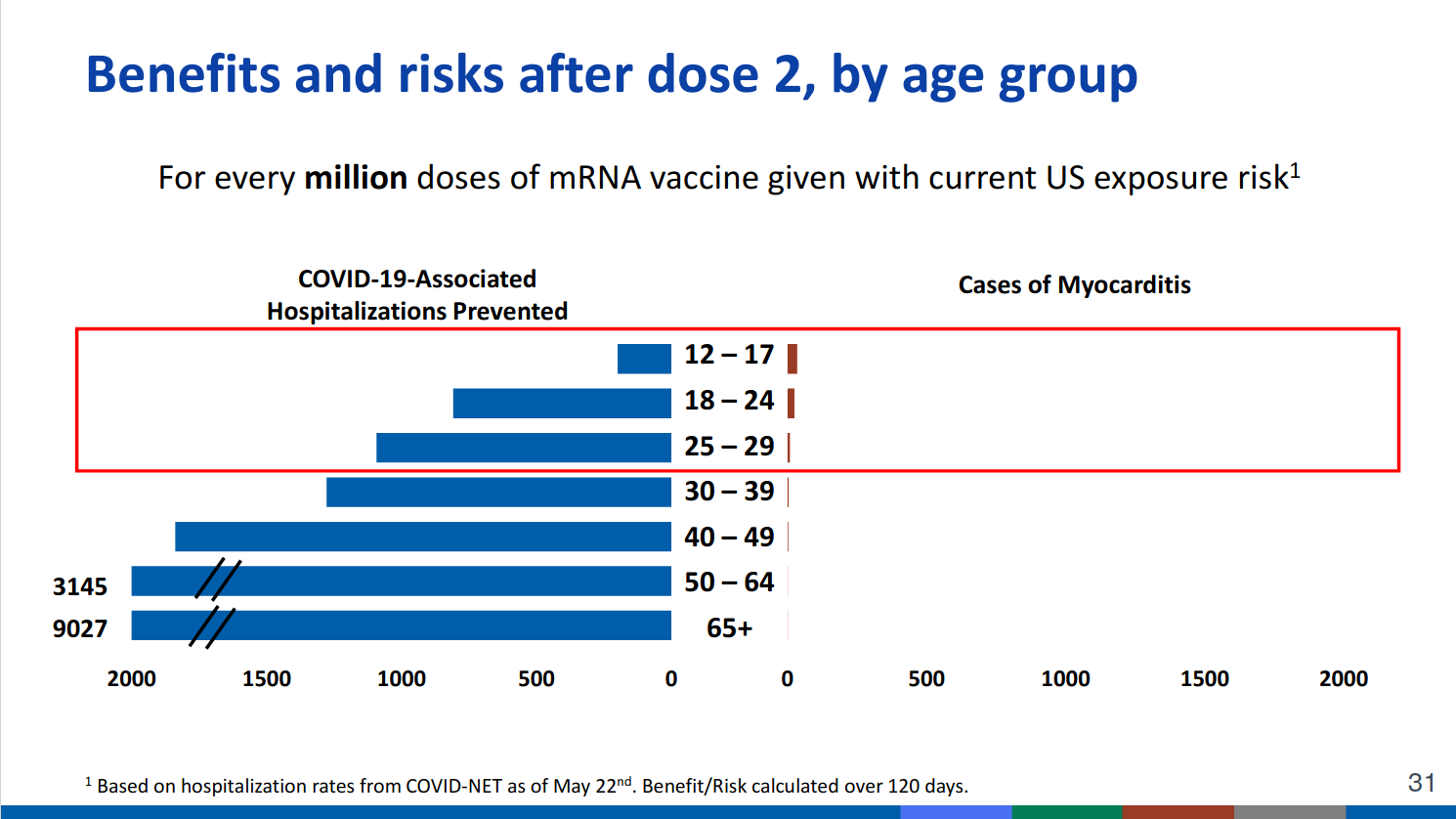
The second of these slides, below, presents “Predicted cases prevented vs myocarditis cases per million second dose vaccinations”.
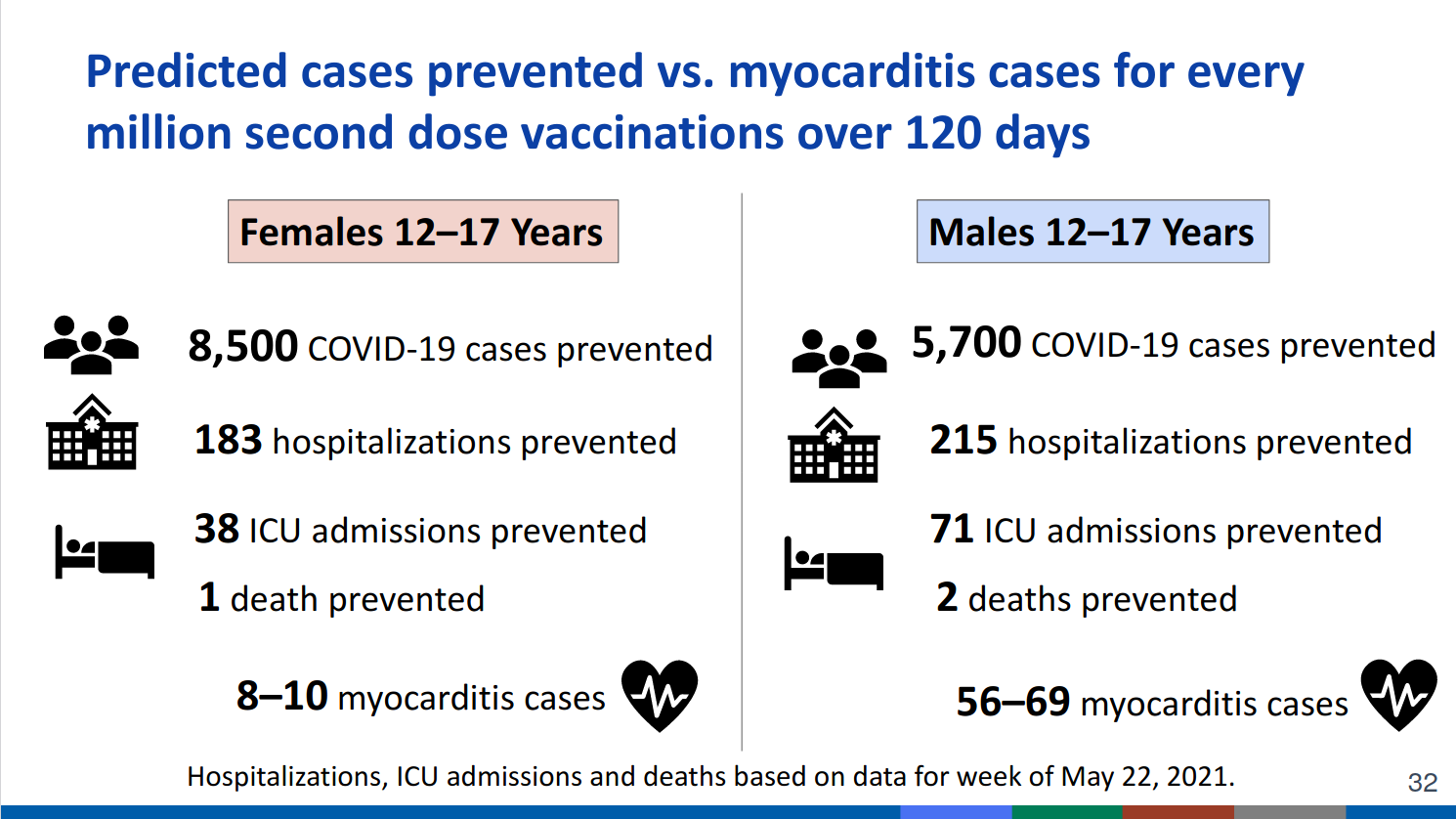
The presentation contains much flawed analysis and misleading framings of data. But above all, despite the fact that these slides purport to weigh risks vs benefits of “dose 2” of mRNA vaccines, this analysis assumes that single doses of mRNA vaccines have 0% effectiveness at preventing COVID-19 associated hospitalization, despite the fact that original Phase 3 trials found high single-dose effectiveness even at preventing infection, and real-world data has confirmed high effectiveness of single doses at preventing hospitalizations, including against recent variants of SARS-CoV-2.
In particular, the counterfactual used for the analysis given for this presentation was not delaying 2nd doses in certain age groups or even forgoing them altogether, but suspending all vaccinations in this age group, including for children with conditions placing them at elevated risk of severe outcomes and death, for a period of 4 months all of which exhibit rates of deaths and hospitalization comparable to May.
ACIP cannot do it’s duty if it does not even address the question before it, which was, most immediately: “do the benefits vs harms of 2nd doses of mRNA vaccines favor giving 2nd doses in younger age groups at this time?”
Answering this question requires understanding not the difference between vaccinating kids and not vaccinating them, but between giving 2nd doses and not giving 2nd doses. The titles of these slides notwithstanding, these slides do not present any data pertinent to that question.
*
It is possible, however, to reconstruct what a more careful balancing of harms and benefits might look like. The first change we will make is simply to incorporate an analysis of the benefit of a single dose of the Pfizer vaccine for the prevention of COVID-19 hospitalization. This was recently estimated at 83% against the alpha variant, and 92% against the more recent delta variant, by Public Health England. We will conservatively assume a single-dose effectiveness of 83% against hospitalization for this illustration, versus a two-dose effectiveness of 95%. With these assumptions, the first slide shown earlier appears quite different:
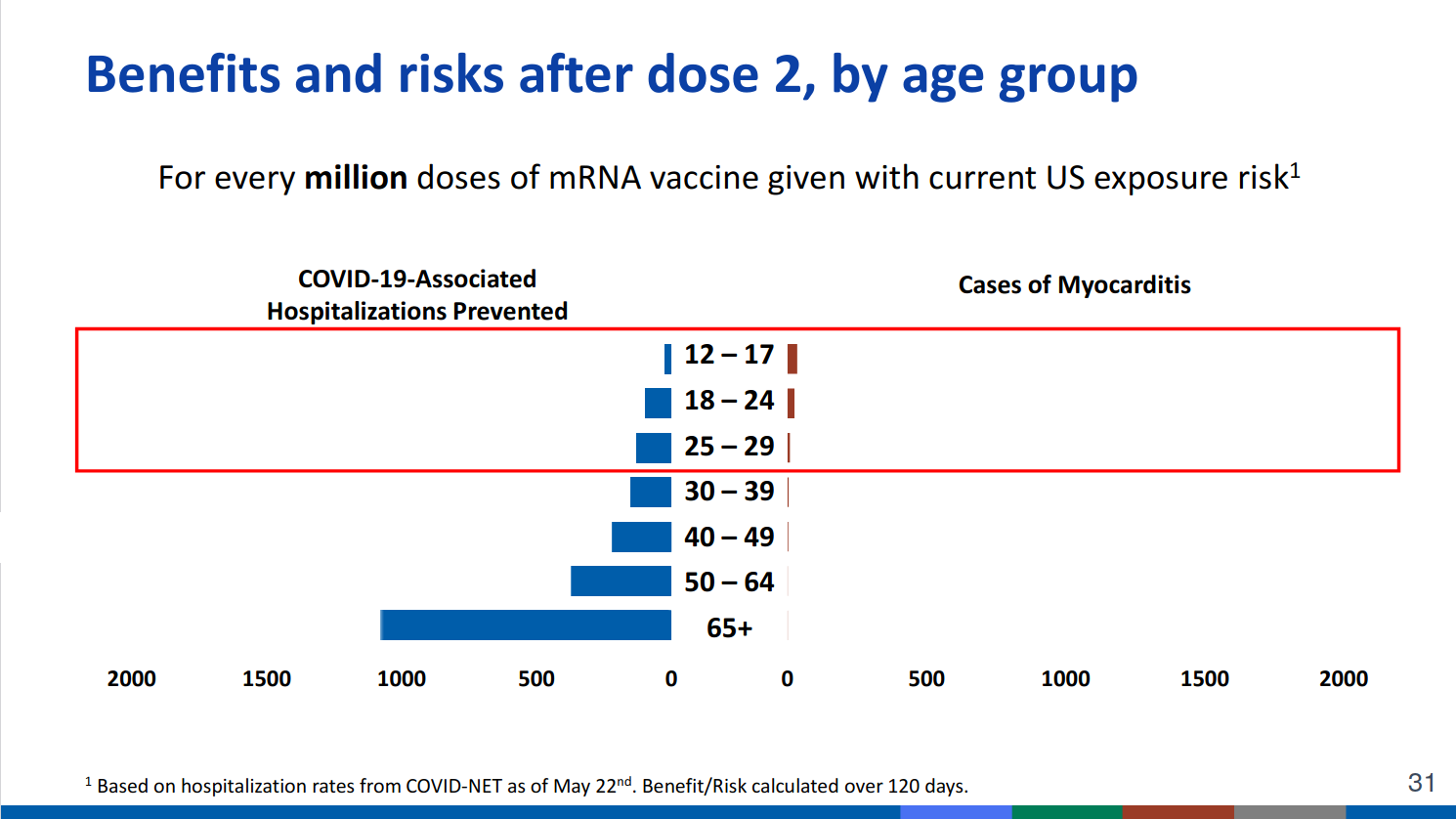
Fewer hospitalizations are avoided in this re-analysis, which only attributes to dose 2 those avoided hospitalizations which would not already have been avoided by dose 1.
After this change, the balance of benefits vs harms is much more delicate, with more cases of hospitalization expected from vaccine-induced myocarditis in 12–17 year olds (even lumping boys and girls together) than COVID-19 associated hospitalizations prevented.
We will consider one further change. The case rate shown on the right-hand side of this figure represents the rate at which CDC-confirmed cases of myocarditis have been recorded through voluntary reporting systems. It is natural to expect this to be an underestimate. Indeed, Israel reported rates of myocarditis betwen 1 in 3000 and 1 in 6000 in 16–24 year olds, with higher rates among 16–19 year olds than 20–24 year olds. this is roughly 5 times higher than the rate of CDC confirmed myocarditis cases detected through voluntary reporting. If we use Israel rates as a proxy for expected myocarditis rates, we obtain the following comparison (simply by inflating by a factor of 5 the CDC-confirmed rate in each age group up to 29).
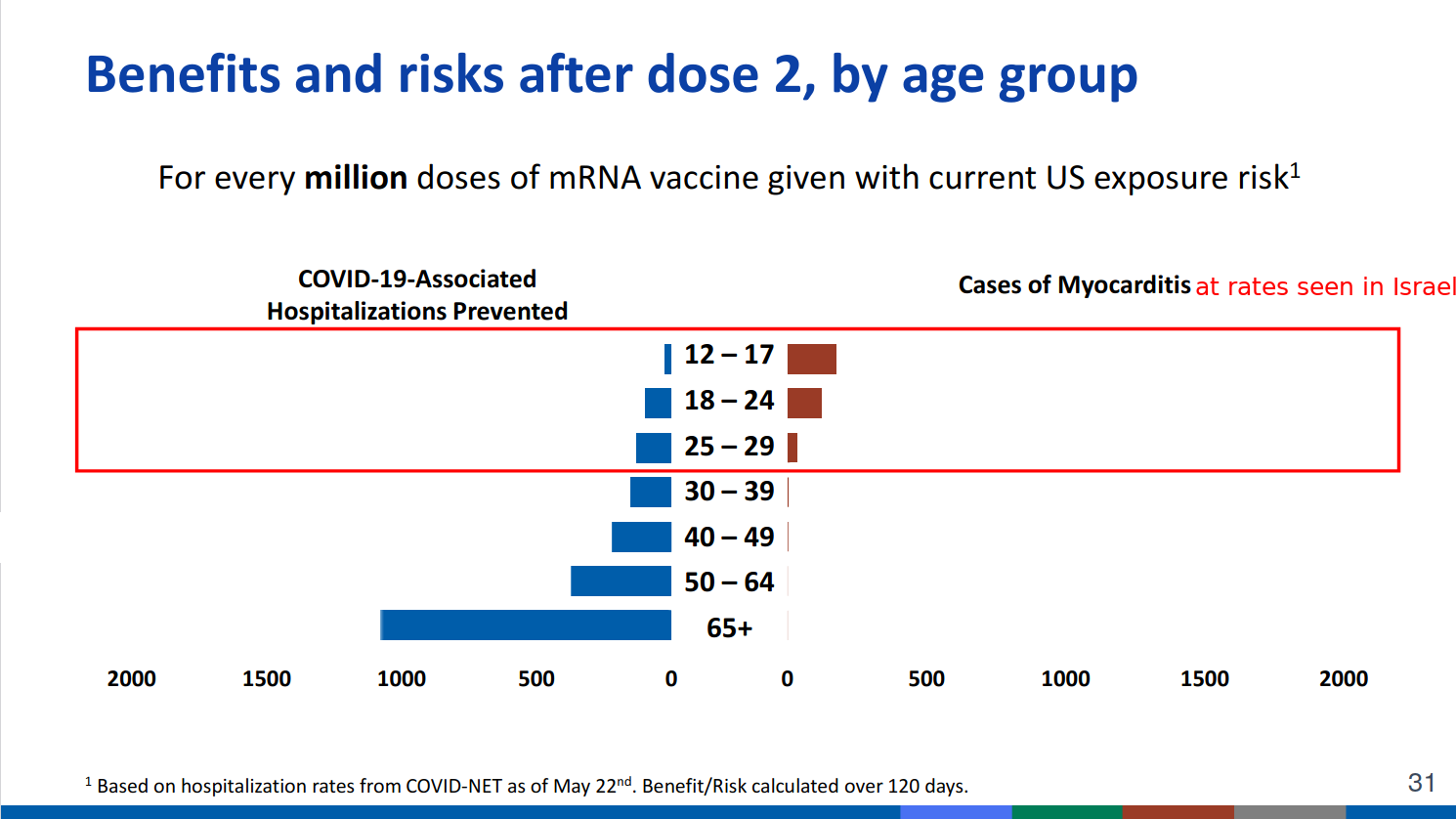
In this re-analysis, we compare COVID-19-associated hospitalizations avoided by the 2nd dose, to rates of myocarditis which would be expected at rates seen in Israel.
In this analysis the harms vs benefits of the 2nd dose appear unfavorable for ages under 25. This is true even though:
- This analysis segregates by age only, ignoring gender, previous COVID-19 infection or health risk factors;
- It still uses May hospitalization rates as the baseline expectation for the next 4 months;
- It does not account for the fact that according to the CDC’s own analysis, 45% of COVID-19 associated hospitalizations in adolescents reported to COVID-NET (which is the source for hospitalization data in this figure) have primary causes other than COVID-19.
The harms versus benefits are particularly bad for 12–17 year olds, as is illustrated if we modify the 2nd CDC slide from above under the assumption that a single dose of mRNA vaccine has 83% VE against severe outcomes, and use rates of myocarditis from Israel as the upper estimate on the number of myocarditis rates (the lower estimates remain unchanged here):
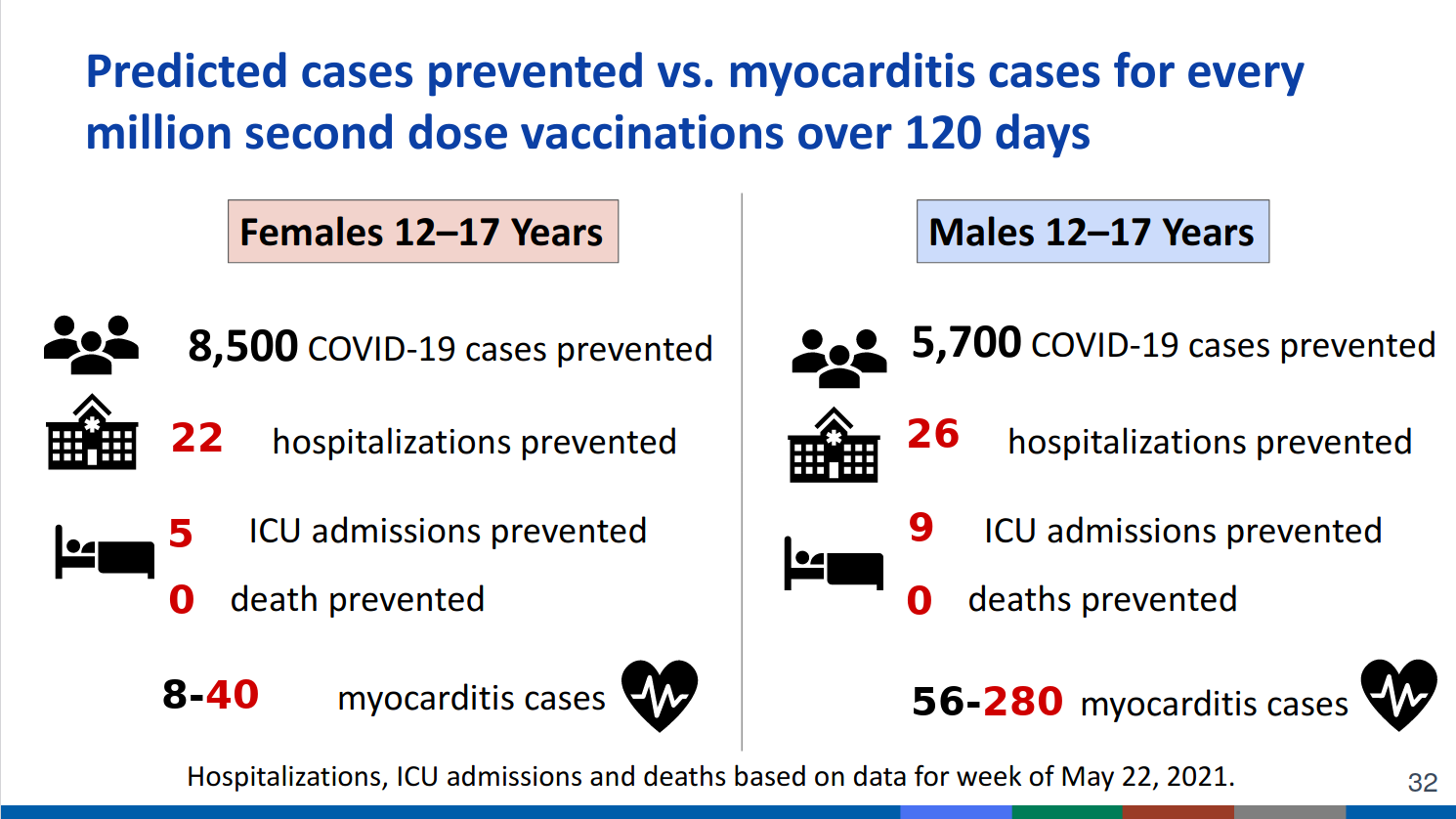
When we account for the marginal benefit of the 2nd dose beyond the 1st dose, rather than attributing all the benefits of vaccination to the 2nd dose, the balancing of harms and benefits appears much more unfavorable in teens.
Note that more than 95% of myocarditis cases detected by the CDC resulted in hospitalization; it seems very likely that 2nd doses of mRNA vaccines will cause more hospitalizations than they will prevent in 12–17 year old boys, and whether that is also true for women will depend heavily on the rate at which the CDC is undercounting myocarditis cases. In the meantime, note that this balance would look even more unfavorable for 2nd doses if it was restricted to healthy children without health factors placing them at elevated risk for severe disease.
In the meantime, the mortality rate of vaccine-associated myocarditis cases remains uncertain. Under questioning during the meeting, Matthew Oster reported that for myocarditis unrelated to COVID-19 or COVID-19 vaccines, mortality rates are estimated in the range of 4%–9% in the literature. Fortunately, it seems likely that the rate is not so high for vaccine or COVID-19 associated myocarditis. But the rate is likely not zero, and the CDC is already investigating one possible death associated with a 2nd dose of Pfizer vaccine in a 13 year old, over a time period where no deaths would be expected to be avoided from 2nd doses of mRNA vaccines in this age group.
*
Note to readers: Please click the share buttons above or below. Follow us on Instagram, @crg_globalresearch. Forward this article to your email lists. Crosspost on your blog site, internet forums. etc.
Wesley Pegden is Associate Professor, Department of Mathematical Sciences, Carnegie Mellon University.
Featured image is from Children’s Health Defense

